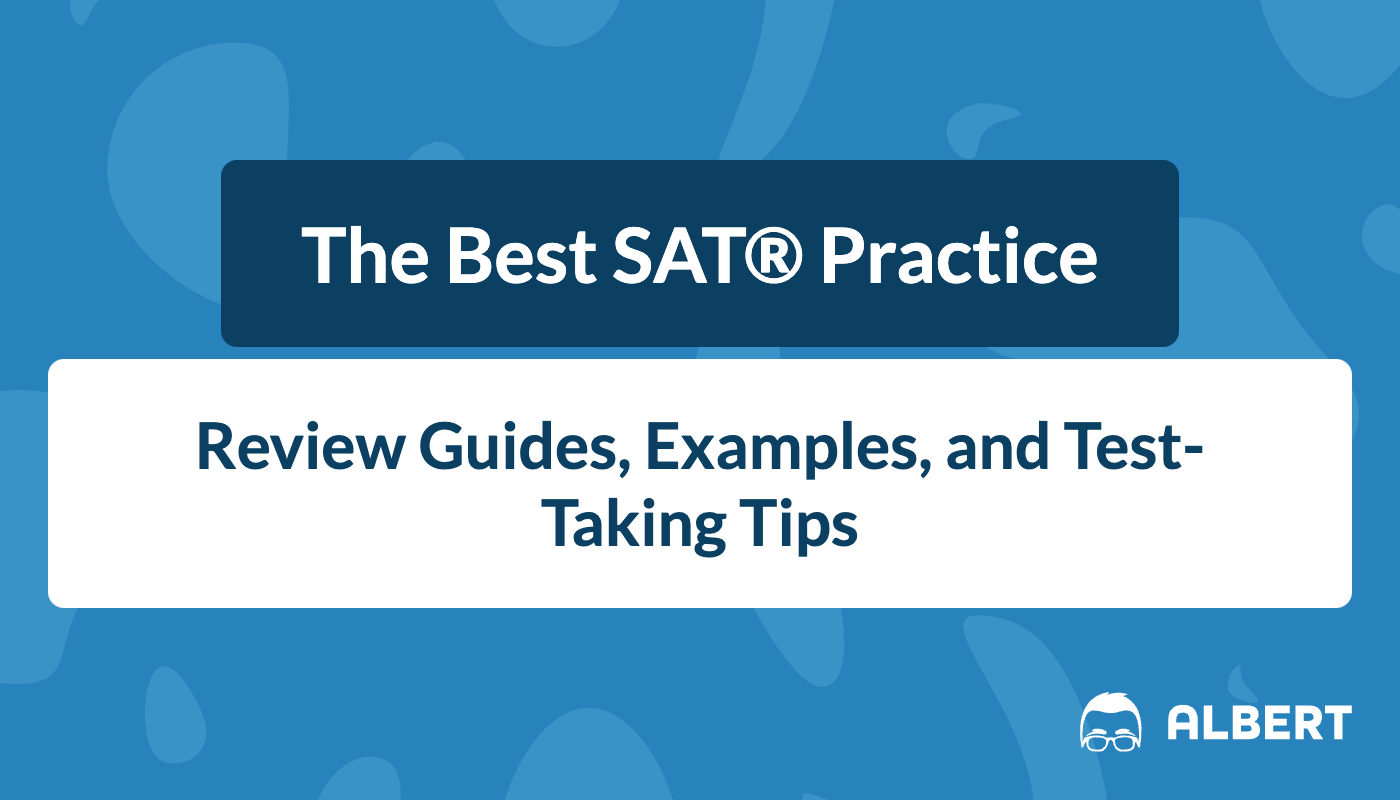SAT® Review
The Best SAT® Practice: Review Guides, Examples, and Test-Taking Tips
Searching for SAT® practice? Boost your SAT® prep with our great collection of resources. Our hub has everything you need for SAT® practice, all chosen to make your study time better. Check out Albert's study guides, practice questions, and tips for taking the test. These resources are here to help you feel more confident and do your best on the big day.
Our resources are updated to match the new digital SAT®. Each post is designed to help you improve SAT® score.
Albert is here to support you every step of the way, with all the tools you need for success on the SAT®!

- SAT® | Scoring and Overview
- SAT® Math | Algebra
- SAT® Math | Advanced Math
- SAT® Math | Problem Solving and Data Analysis
- SAT® Math | Geometry and Trigonometry
- SAT® Reading and Writing | Craft and Structure
- SAT® Reading and Writing | Information and Ideas
- SAT® Reading and Writing | Standard English Conventions
- SAT® Reading and Writing | Expression of Ideas
SAT® | Scoring and Overview
What is the SAT®, and why is it important for college admissions? How is the SAT® scored, and what does your percentile mean?
The articles below break down everything you need to know about the structure and purpose of the SAT®, from section breakdowns to score reports. Whether you're aiming for a top percentile or just trying to understand your composite score, you'll find tools like our SAT® score calculator and percentile charts to guide your study plan and set realistic goals.
SAT® Math | Algebra
What does it mean for an equation to have no solution, one solution, or infinitely many? How do you translate a real-world situation into a linear equation or function?
The review articles below build your skills for solving one-variable and two-variable linear equations, working with functions, and interpreting the meaning of constants, variables, and terms. From understanding how to rearrange and solve equations to modeling relationships and analyzing solution conditions, these resources will help you master the algebra concepts most commonly tested on the SAT® Math section.
SAT® Math | Advanced Math
How do you solve quadratic, rational, or radical equations efficiently and accurately? How can you use structure to simplify expressions, model relationships, or interpret complex functions?
The review articles below guide you through the most advanced algebra skills tested on the SAT® Math section. You’ll practice solving nonlinear equations, working with polynomials, and interpreting function behavior across multiple representations. Whether factoring, manipulating rational expressions, or comparing exponential and quadratic models, these lessons help you build fluency with structure and strategy.
SAT® Math | Problem Solving and Data Analysis
How can you use ratios, percentages, and units to solve real-world problems? What do data displays, models, and statistics reveal about trends and predictions?
The review articles below focus on the data-driven reasoning needed for SAT® Math success. You’ll explore how to analyze graphs, apply rates and proportions, calculate statistical measures, and evaluate data models. From interpreting scatterplots to understanding sampling methods, this section strengthens your ability to reason through everyday math scenarios using real-world data.
SAT® Math | Geometry and Trigonometry
How do you apply theorems and formulas to solve real-world geometry problems? What relationships exist between angle measures, side lengths, and the unit circle?
The review articles below focus on the essential geometry and trigonometry concepts tested on the SAT®. You'll explore triangle congruence and similarity, right triangle trigonometry, circle equations, and geometric formulas involving area, volume, and scale factors. From understanding radian measures to solving problems using the Pythagorean Theorem and special right triangles, these lessons help you master the geometry skills critical to boosting your math score.
SAT® Reading and Writing | Craft and Structure
How do context clues help determine word meaning? How can you analyze an author's purpose or text structure?
The articles below focus on the key skills needed for success on the SAT® Reading and Writing | Craft and Structure questions. You will review understanding words in context, analyzing text structure and author's purpose, and comparing two related texts. These resources offer clear strategies, tips, and practice to help you boost your score on the newest combined Reading and Writing module.
SAT® Reading and Writing | Information and Ideas
How do you determine a text's central idea? How can you infer meaning from a passage?
These articles will help you prepare for SAT® Reading and Writing | Information and Ideas questions. You will learn how to identify the central idea and supporting details of a text and how to infer meaning. You can also practice locating and evaluating evidence from text as well as charts and graphs. Elevate your SAT® Reading and Writing score by building key reading skills with these review guides!
SAT® Reading and Writing | Standard English Conventions
What is a comma splice? What is a misplaced modifier? How can you connect complete sentences?
Practice for the SAT® Reading and Writing | Standard English Conventions questions with these review guides! These articles review grammar, usage, and punctuation rules that are commonly tested on the SAT®. Whether you need to review when the use a comma or how to avoid fragments, run-ons, and misplace modifiers, these guides are for you!
SAT® Reading and Writing | Expression of Ideas
How do you choose the best transition word for a sentence? How do you synthesize research to answer a research question?
Get ready for SAT® Reading and Writing | Expression of Ideas questions with these step-by-step review guides. You will learn how to choose the best transition word to unify ideas and how to synthesize research to achieve a writing goal. These resources will improve your confidence and help you ace the SAT® Reading and Writing exam!
Interested in a school license?
➜ SAT® & ACT®
➜ AP®
➜ ELA, Math, Science, & Social Studies
➜ State assessments
Options for teachers, schools, and districts.

